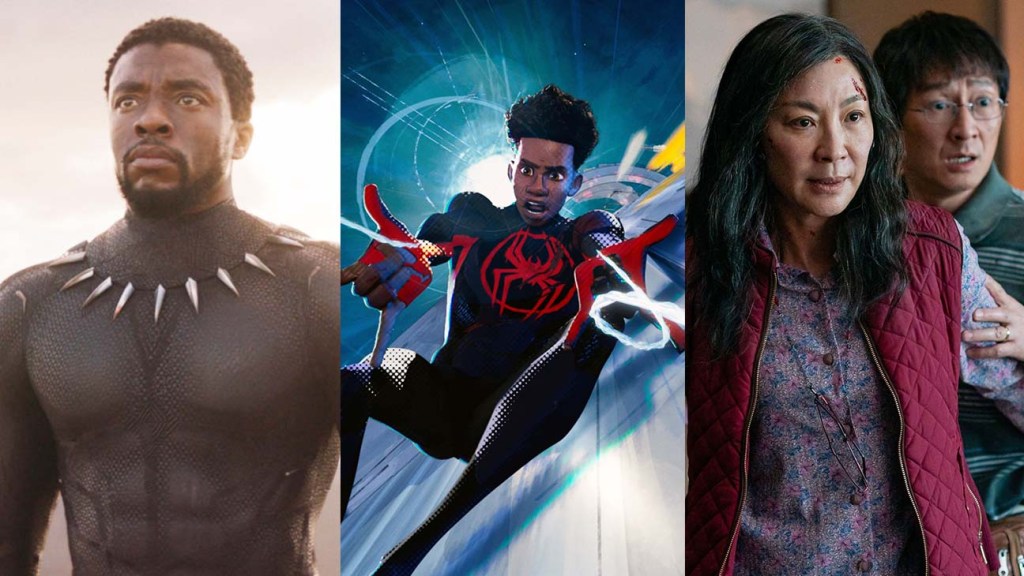
‘Black Panther,’ ‘Spiderman: Across the Spider-Verse’ and ‘Everything Everywhere All at Once’
Marvel/Walt Disney Studios Motion Pictures/Courtesy Everett Collection; Sony Pictures Releasing/Marvel Entertainment/Courtesy Everett Collection; Allyson Riggs/A24/Courtesy Everett Collection
Who would pass up $30 billion? Hollywood’s top decision-makers and gatekeepers, apparently.
Beginning in 2021, the consulting firm McKinsey has published a series of reports exploring the entertainment industry’s representation and inclusion of historically excluded people. Along the way, the analysts totaled up the potential financial revenue that Hollywood could stand to gain if it adopted more culturally inclusive business solutions: $10 billion per year from closing the Black inequity gap, an eye-popping $12 billion to $18 billion from properly valuing Latino professionals and consumers, and — in the latest report released today, conducted in collaboration with Gold House — $2 billion to $4.4 billion from more effectively tapping the Asian and Pacific Islander market.
The latter figure is calculated based on U.S. Bureau of Labor Statistics data that Asian Americans earn on average 30 percent more than non-Asian Americans but spend 35 percent less on media. Meanwhile, McKinsey’s own survey of API consumers found that nearly half would spend more money (49 percent) and time (47 percent) on film and television with more authentic representation. Put plainly: Asian Americans have a lot of money, and they would spend more of it on media if it better reflected them.
With movies like Everything Everywhere All at Once and Parasite and television series like Beef and Squid Game sweeping awards and artists like Dwayne Johnson, Taika Waititi and Mindy Kaling on the celebrity A-list, it’s true that Asians and Pacific Islanders are enjoying unprecedented levels of prominence and prestige in current pop culture. But there are a couple of caveats to keep in mind; for one, the progress is relative — almost anything is better than a handful of major roles every few decades, especially when that representation includes characters like Mr. Yunioshi, Apu and Long Duk Dong.
Secondly, although API representation in film leapt from 3 to 20 percent in the 20 years between 2002 and 2022, 85 percent of that recent representation is in movies produced outside the United States, and episodic television has seen similar trends. AAPIs (6.2 percent of the U.S. population) are still underrepresented by 50 percent in content made in their own country (3.4 percent of lead roles in U.S.-produced films), which means that the API faces seen onscreen do not necessarily reflect the experiences and perspectives of Asian Americans and Pacific Islanders living here.
Furthermore, API representation has a pronounced genre skew. Nearly half of wide-release features with API leads are action-adventure movies (for films that grossed more than $50 million, that figure rises to 71 percent), and movies with API leads tend to be increasingly race-agnostic (as opposed to having narratives specific to an API cultural experience) the more widely they are distributed. For example, in the five years between 2018 and 2022, 76 percent of American movies in limited theatrical release with at least one API lead (i.e. The Farewell) were considered race-specific, compared with just 37 percent of wide-release features. This phenomenon of cultural invisibility is not shared across other racial groups; for example, McKinsey’s 2021 report on Black representation in Hollywood found that Black-led films were twice as likely to be race-specific as race-agnostic.
Disaggregating representation data — by genre, by producing country, by qualitative analysis — is particularly crucial for the umbrella identity known as API, which tends to obscure or outright erase the Pasifika (Native Hawaiian and Pacific Islander) part of the moniker. Half of the 310 API lead roles in movies from 2018 and 2022 were played by actors of East Asian descent; the 17 Pasifika leads in those five years were played by just five men, who were mostly in action movies and who were mostly Dwayne Johnson and Jason Momoa.
“As our research and analysis have demonstrated, executives don’t need to act out of altruism,” the McKinsey authors write of the reasons for improving on- and offscreen representation. “The reward for getting it right could create real impact for the industry — and the prize will only grow. Progress may not be easy, but when the enhanced richness of storytelling is accompanied by a multibillion-dollar opportunity, the business case is clear.”









